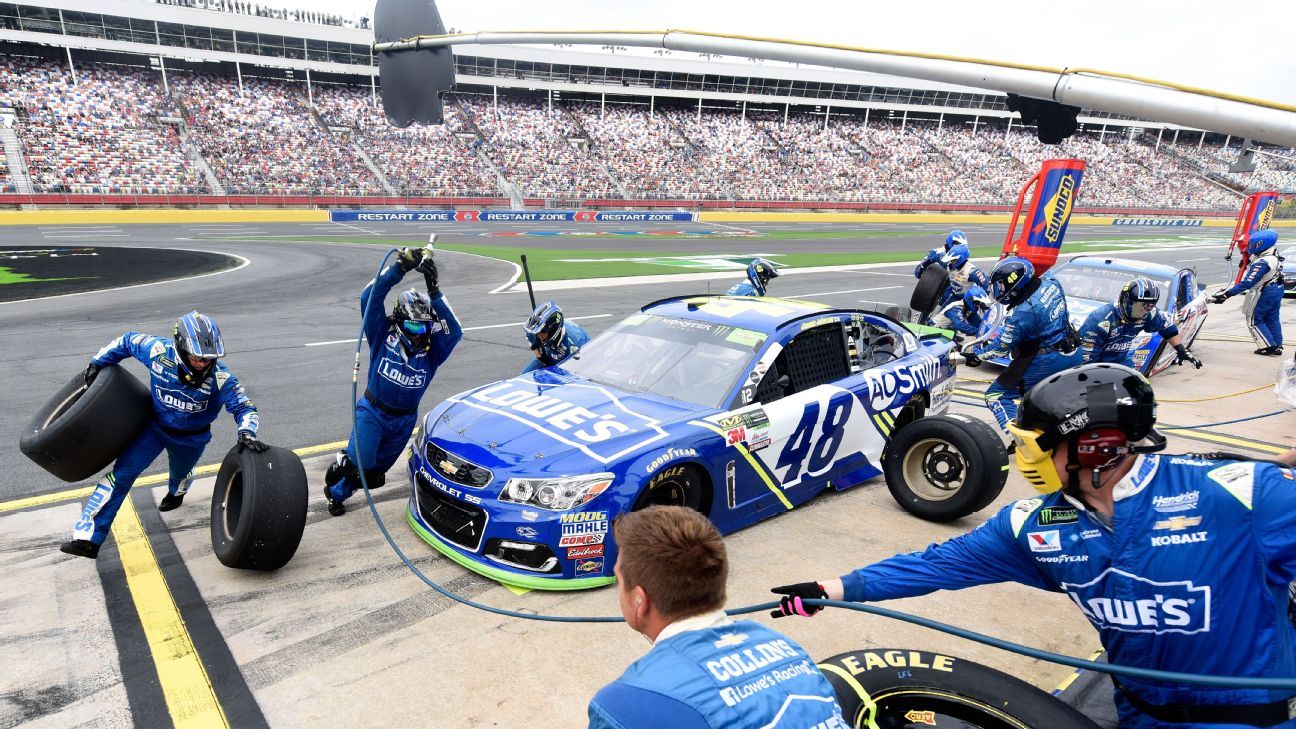The NASCAR industry had hoped a downward spiral in attendance and ratings would not be so dramatic in 2018, but the numbers tell a different story.
With all three public companies now having reported earnings for the first half of the year, their admissions revenue numbers show a significant drop in ticket sales.
The figures from International Speedway Corp., Speedway Motorsports Inc. and Dover Motorsports Inc. show a 14.7 percent drop in admissions revenue for 14 NASCAR Cup Series weekends after the Daytona 500. There are some additional events — four NHRA events, an IndyCar weekend and Daytona’s motorcycle races — included in those numbers, but NASCAR makes up the vast majority of the admissions revenues.
Television ratings for the first 16 events (the Fox portion of the season) were down approximately 20 percent, according to ISC, with an average of 4.1 million viewers per race.
There also have been some high-profile sponsorship announcements that haven’t gone NASCAR’s way. Lowe’s and 5-hour Energy have been among the sponsors who have announced they are leaving after this year, though NASCAR chief marketing officer Steve Phelps says “almost half” of the Fortune 100 and “almost a third” of the Fortune 500 companies are involved in NASCAR.
“I think this industry tends to focus on the negative,” Phelps said. “I’m not really sure why. … It’s a lot of large companies who are in the sport, not because it would be really cool to go racing, [but] it’s because it works.”
Phelps was speaking at a news conference in which Camping World CEO Marcus Lemonis talked about replacing Camping World with one of his recent purchases — Gander Outdoors — as the title sponsor of NASCAR’s truck series.
“There’s this notion that sports sponsorship has sort of lost its way,” Lemonis said. “But we’re here to tell you as a company that our relationship with NASCAR has really paid dividends over the years. … We know that fans are looking for simpler, easier, less expensive — and we [at Gander Outdoors] as a retailer have an obligation to do that — and we want to use NASCAR as a platform to communicate that.”
The corporate side of the track business is going well in the sense that SMI reports it already has sponsorship for 11 of its 13 Cup events for 2019.
But as teams look for sponsorship, they see the dip in attendance and ratings and feel the pressure to convince sponsors that fans are still consuming the sport. The public companies reported just a 2.7 percent overall drop in 2017, which appeared to show that they had made progress after a 7.4 percent drop in 2016.
The good news for teams is companies are looking for different ways to activate their sponsorships, said team owner Rick Hendrick. As he seeks a sponsor for Jimmie Johnson amid the departure of Lowe’s, he said there is “good energy around” the sponsorship search for the seven-time champion.
“The way people go to market definitely [has] had an effect,” Hendrick said. “With what Jimmie represents, and what he’s done in the sport, and the way the fans feel about him, we feel pretty good.”
The big question is: How do teams price non-racecar assets? If a place on the car is not what a company really wants — but it wants significant digital presence — how does the team value a race sponsorship even when the logo on the car isn’t the most valuable commodity? Does a team not offer a certain number of digital assets without garnering enough sponsorship to field for a certain number of races?
For a team such as Hendrick, it often has to turn away prospective sponsors. Hendrick just re-signed Mountain Dew with Chase Elliott, which likely would keep other non-Pepsi beverage companies out of contention if they want access to all of Hendrick’s portfolio.
“You have got to have something that fits with everything else in this deal, and we’ve got as many sponsors as we have,” Hendrick said. “That is a problem for you. We’ve had people that were conflicts. But I feel good [it will get done].”
Those in the NASCAR industry will point to attendance and ratings issues in all sports. But NASCAR enjoyed such a boon just 10 years ago that the numbers are startling. The three public companies reported overall admissions revenue of $215.1 million in 2017, a drop of 54 percent from 2007, when the companies hit an all-time high of $467.4 million.
ISC says it is emphasizing exclusive VIP hospitality experiences and driver appearances as well as ticket packages aimed at youth and younger demographics, with kid pricing and family-targeted promotions.
“We think these initiatives are going to bear fruit, and so we remain optimistic in these initiatives, and we are going to stick to them,” ISC president John Saunders told financial analysts last month.
SMI gave a similar report in its most recent financial disclosures, citing that a portion of the decline can be attributed to changing demographics, which most sports face.
SMI states: “We continually search for new and innovative promotional campaigns to foster attendance by families, particularly those with younger children and teenagers. … We are attempting to capture the interest of the next generation of race fans through kid-friendly entertainment options, free tickets to kids under 12 for families attending NASCAR Xfinity and Camping World Truck Series races, family camping, kids’ zone play areas and kids’ clubs, as well as offering kid-sized headsets for scanners.”
The sanctioning body also is trying to help. It is working with television partners for more mentions of where fans can get tickets, and it also is using nearly all its NASCAR in-race TV advertising inventory — 95 percent instead of about 70 percent in the past — to promote ticket sales or when future races will be televised. The NASCAR website is running more ads with info on tickets and television schedules, and NASCAR, along with the television partners, is focusing digital and TV advertising in areas that have high NASCAR fan bases.
NASCAR touts race consumption numbers that it believes show strength. NASCAR has ranked among the top-two sporting events on television during a weekend in 11 of the first 21 races. Its social media engagements on race day are up 19 percent, video views on its website are up 29 percent and its fantasy pages are up 125 percent.
“Viewership trends for major sporting events on linear television broadcast is rapidly changing, with mixed results and many experiencing declines,” ISC stated in its most recent earnings report. “The NBA playoffs saw increases year-over-year, but the Finals series viewership were down versus prior year. The NHL playoffs saw favorable results, but the season had the lowest viewership since the 2010-2011 season.”
The tracks also blame weather and scheduling for some of their woes (although there were weather-impacted events in 2017). Las Vegas, with a second date this year that comes in September, was soft for its first race, likely because of the addition of the second date, according to SMI. ISC said the Phoenix reconstruction project cost it some fans in March but is hopeful it increases attendance when completed by November. ISC also indicated that a soft Chicagoland gate was the result of the move of the race from September to July, and that attendance will build as the summer date continues in upcoming years.
Recent retirements of drivers have also been cited as a cause, and Saunders caused a stir last month saying the younger drivers had not won enough yet to increase their brands.
“From time to time, extremely popular and long-standing successful racecar drivers (“megastars”) such as Dale Earnhardt Jr., Jeff Gordon, Tony Stewart, Carl Edwards, Matt Kenseth and Danica Patrick announce their retirement or reduced motorsports racing due to age, health or other considerations,” SMI’s most recent report said.
“Racecar driver popularity and performance abilities can affect on-track competition, the closeness of championship points racing, attendance, corporate interest, media attention and the appeal and success of racing in general.”
The tracks are still making profits (partly thanks to the new tax laws), and SMI’s stock dropped just 1.3 percent after it announced its earnings Wednesday. ISC’s investment in its Kansas casino and a retail development center in Daytona have helped increase profits.
The NASCAR television rights deal has had a 4 percent increase in television dollars, which has more than offset the drop in admissions revenue. ISC earned $117 million in broadcast revenue through May, while all of its tickets sold combined to $56.2 million. SMI took in approximately $62.2 million through June, while its overall admissions revenue was $36.275 million.
Lemonis said that NASCAR, like all companies, must listen to the people consuming the product.
“We can never take our eye off the single ball, which is our customers and our fans are the reason that we exist. And so if we’re not curating something for them, at the price points that work for them, with the experience that works for them, they’ll vote us out by not showing up,” Lemonis said.
“And so I think we need to be very careful that, whether it’s in our stores or at our tracks or in our sponsorships, that we’re remembering who our boss is, and that’s our customer. And I think the minute we forget that, we’re out of business.”

